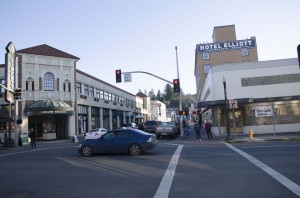Dec 8 2013
The City Council on December 2, 2013, adopted without voter approval an ordinance changing a zone use contrary to intent and wording in the City Charter. Zoning changes known as reclassifications have been under the strict authority of voters for well over a half century, perhaps since the origin of Piedmont in 1907. However, voter approval requirements were dismissed December 2, as the Council assumed the
Charter language –
The City Charter states that voters must approve zoning use changes under “SECTION 9.02 ZONING SYSTEM”:
“The City of Piedmont is primarily a residential city, and the City Council shall have power to establish a zoning system within the City as may in its judgement be most beneficial. The Council may classify and reclassify the zones established, but no existing zones shall be reduced or enlarged with respect to size or area, and no zones shall be reclassified without submitting the question to a vote at a general or special election. No zone shall be reduced or enlarged and no zones reclassified unless a majority of the voters voting upon the same shall vote in favor thereof; provided that any property owner which is zoned for uses other than or in addition to a single family dwelling may be voluntarily rezoned by the owners thereof filing a written document executed by all of the owners thereof under penalty of perjury stating that the only use on such property shall be a single-family dwelling, and such rezoning shall not require a vote of the electors as set forth above. ” City Charter . Emphasis added.
New interpretation of residential use –
The Council approved a new interpretation of residential use allowing single family residential use to be interchangeable with multiple family (apartments) residential use. Since its beginning, Piedmont has been a primarily single family residential city evidenced by history and the limited commercial buildings and apartments in the City. The state, working through staff and consultants, persuaded the current council to change the Charter interpretation without following traditional and established law requiring Piedmont voter approval.
The Charter states specifically:
“provided that any property owner which is zoned for uses other than or in addition to a single family dwelling may be voluntarily rezoned by the owners thereof filing a written document executed by all of the owners thereof under penalty of perjury stating that the only use on such property shall be a single-family dwelling, and such rezoning shall not require a vote of the electors as set forth above. “
The Charter language shows a change in use is reclassification requiring voter approval – examples: “for uses ” and “only use.”
Piedmont governance is based on the City Charter –
The raison d’etre for the organization of Piedmont’s governance through the City Charter was to establish the principle that the very small community of Piedmont would let the citizens make major decisions about governance and content of the community to an extent difficult in larger cities where officials have greater authority to make zoning decisions for the citizens.
No Piedmont vote proposed –
Not once during Council consideration was a motion made to place the matter on a Piedmont ballot. Election timing, costs, ballot arguments were forgone in preference to Council determination of what was appropriate for Piedmont avoiding the risk of allowing voters to approve the change.
New City Attorney sways Council –
The pivotal junction in the Council’s decision was the opinion of a new temporary City Attorney, who verbally convinced the City Council that “residential is residential.” Leading to a decision that single family residential use allows multifamily residential use under a Conditional Use Permit when individually granted by the Planning Commission.
Council approval of zoning change –
The Council’s approval of Mixed Use (apartments in conjunction with business) in the Commercial Zone D changed the use allowed in the zone. Mixed use language has been placed into the revised Chapter 17 of the Piedmont City Code by the City Council. Where apartments were not allowed, they will now be allowed through a conditional use permit process in the Commercial zone. This change expands the multifamily residential zone parcel by parcel enlarging the multifamily zone. Establishing a pathway through new interpretations of the Charter, opens the door for all of Piedmont to change without voter approval.
Council avoids voter approval while potentially impacting all of Piedmont –
The Council forfeited the long held interpretation, intent and definition of Charter zoning language which defined the classification of a zone as its use. Piedmont zoning laws specifically allow single family dwellings in all areas /zones. The new interpretation establishes a gateway for all of Piedmont to have its zoning changed through new special permits approved by the City Council.
Precedent of interpretation of “residential is residential” –
Upon repeated questioning from Council members concerned about precedent setting based on the new interpretations, the City’s attorney stated no precedent would be set. There was no explanation on how terms as “classification /reclassification” and “residential is residential” could be established now, yet not set a precedent for future application of the same words. Nor was there an explanation on how parcel by parcel use changes leveled with the Charter.
Attorney based interpretation of Charter language on other cities rather than Piedmont. –
The advising attorney relied on current practices in other cities with no relationship to the Piedmont and expounded on the term “reclassification” as being a broad term applying only to a very consequential change in zoning when an entire zone would be changed to another use.
In fact, the opposite is true in Piedmont. It has been the practice of the City to require voter approval of use changes even when a single parcel’s use was changed from one use zone to another. This was implemented recently, when Piedmont voters readily approved reclassifying 801 Magnolia Avenue, the site of the current Piedmont Center for the Arts previously zoned Single Family Residential Zone to Public Facilities Zone. The process and ballot measure involved one parcel.
Previous Councils defined “classification as the use”. –
Another example of the established definition of “classification” as “use,” was in 1987 when the Council voted to create two separate single family residential zones, one for single family residential parcels with a minimum 10,000 square feet (Zone A) and another zone for single family residential parcels with a minimum 20,000 square feet (Zone E – Estate). This was done by the Council without voter approval on the basis that there was no change of use. The Council stated that the use within the zone was not changing, consequently it was not a new zone, even though one zone was reduced, Zone A, and Zone E, the Estate Zone was created out of Zone A. In Chapter 17 of the City Code, there are two separate single family residential zones, Single Family Residential (Zone A) and Single Family Residential Estate (Zone E), approved by the Council because the use did not change.
No written legal opinion on the language interpretation presented –
Despite the pivotal nature of the new definitions of classification and reclassification, as of this publication, no prior written legal opinion on new definitions and interpretations of the City Charter language have been provided to the public and, evidently, not to the Council or Planning Commission before their decision to accept the new interpretations. Several requests by the Piedmont Civic Association were made to City staff for prior written legal opinions, yet to date no response or information has been forthcoming.
Every Piedmont property impacted by the new interpretation of the Charter
The new interpretation of the Piedmont Charter language “classification and reclassification” and “residential is residential” creates a conundrum of issues. The most controversial is establishing an interpretation impacting every Piedmont property in every zone. Since every zone allows single family residential, every Piedmont parcel is a potential apartment site based on Council action allowing use changes.
Zoning change lacks Design Review Guidelines for Highland/Vista and Grand Avenue –
The change becomes effective January 1, 2014, however, the Council and Planning Commission have not considered laws to control height, set backs, parking, hardscape, etc. within the zone, leaving a void. Discussion of separate conditions for the two commercial zones (Highland/Vista and Grand Avenues) were deferred, while the ability to build Mixed Use projects on all properties will be law.
Zoning is important to Piedmont –
Zoning has been the mainstay of Piedmont. Neighboring communities have faltered, while Piedmont has remained stable and sound largely based on zoning. As the state continues to want higher density housing, the new interpretation of the City Charter removes the strength provided by the Charter language requiring voter approval prior to zoning changes.
Council approval of the new interpretation might be the most expedient appeasement of state requests, but it has weakened Piedmonters ability to govern their city through voters rights found in the City Charter.
Option available to City Council:
The City Council can act to consider the broader implications and future of Piedmont zoning by following the City Charter and allowing voters of Piedmont to vote on the proposed changes to Zone D Commercial, thus protecting the remainder of the City from “new definitions and interpretations” that
Editors’ Note: The Piedmont Civic Association takes no position on whether apartments should be allowed in Commercial Zone D or any other Piedmont zone. The Piedmont Civic Association takes a definite position advocating adherence to the language in the Piedmont City Charter which states voters must approve changes in zoning use classifications.
The Piedmont Civic Association does not support or oppose





